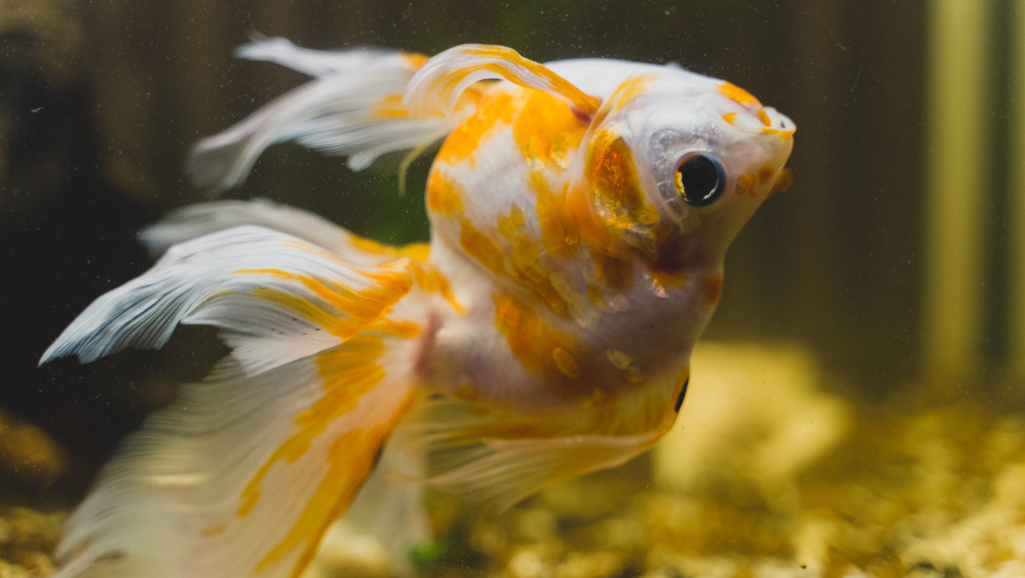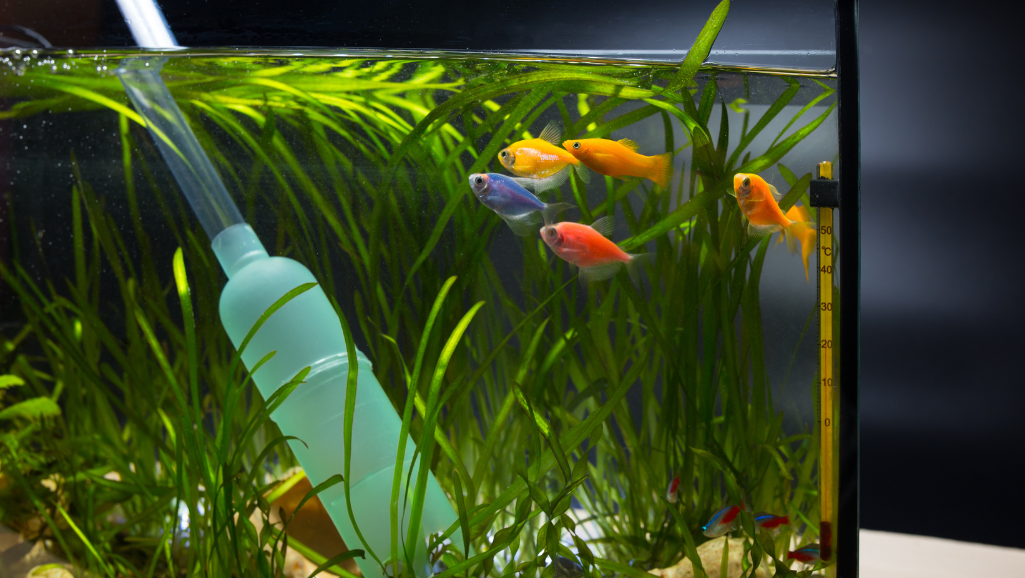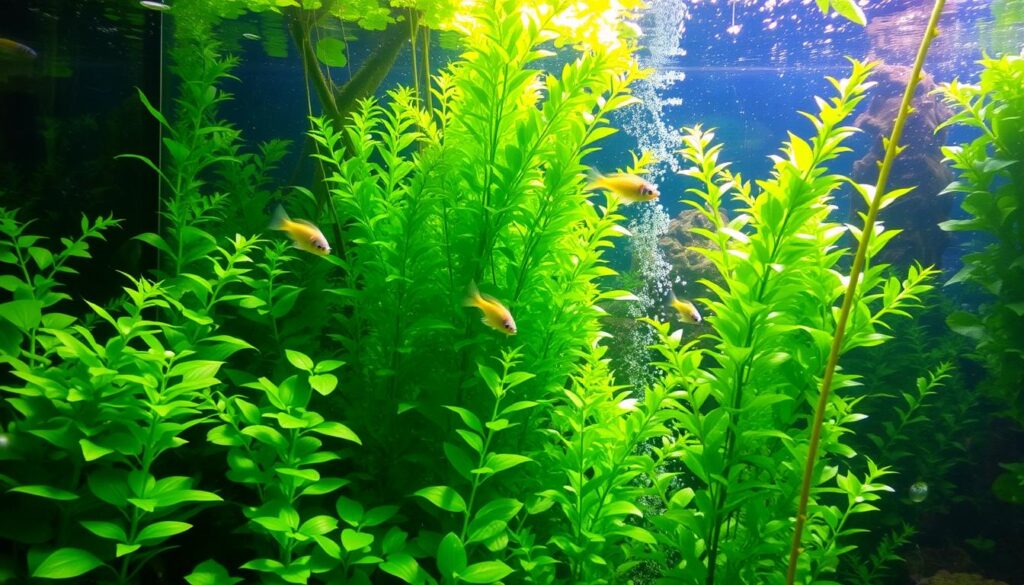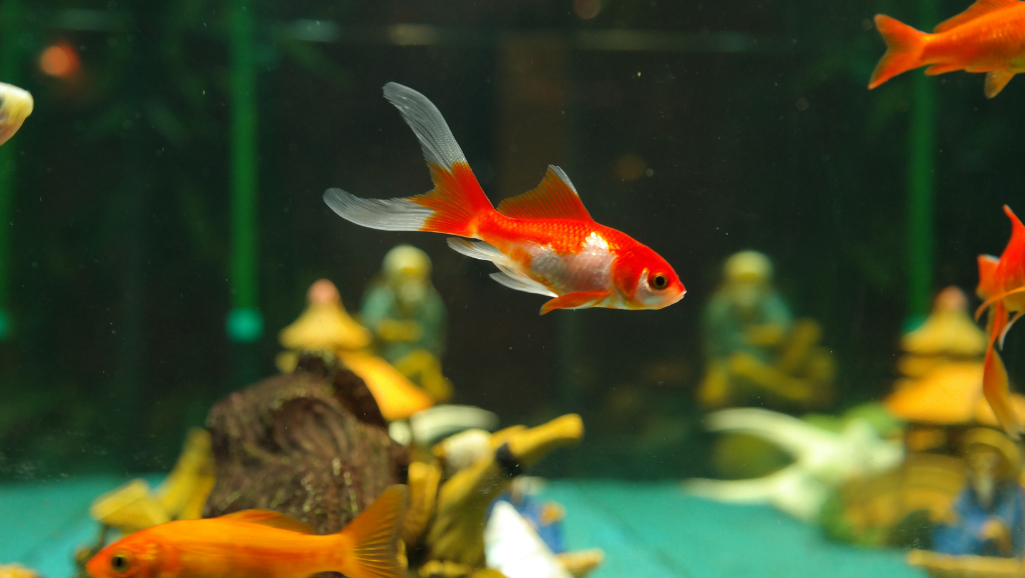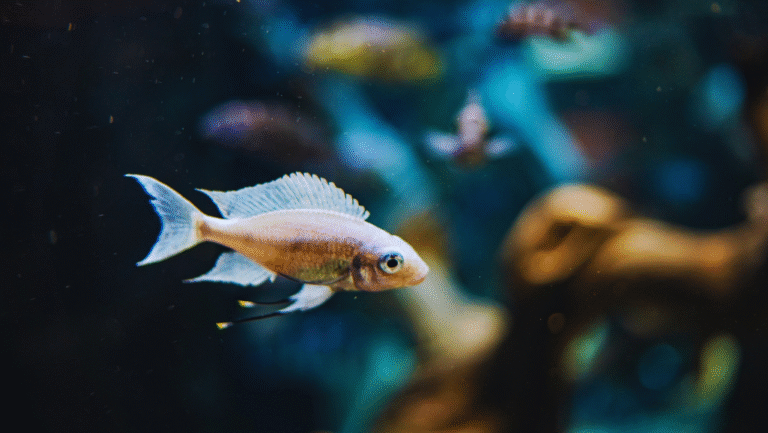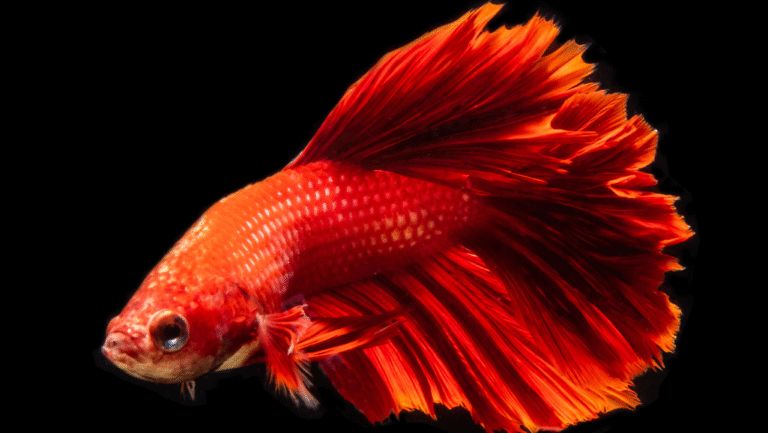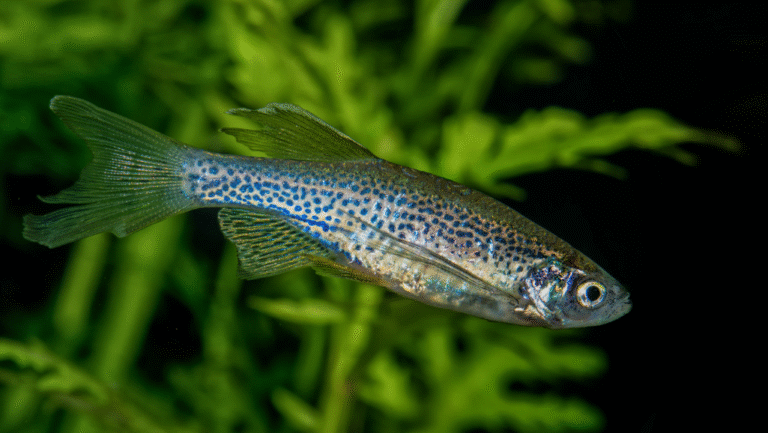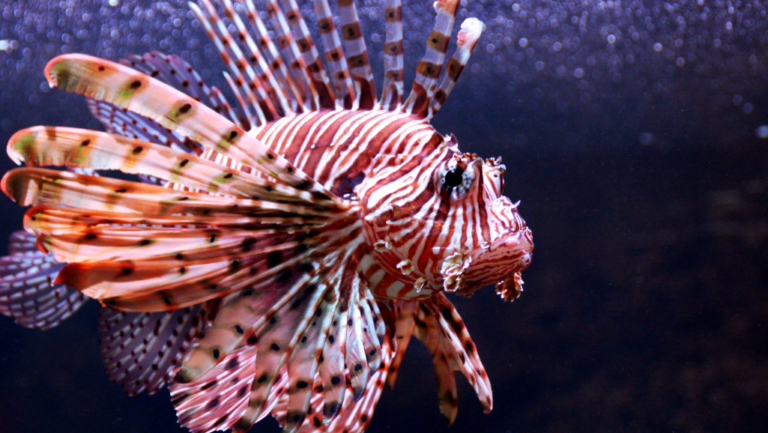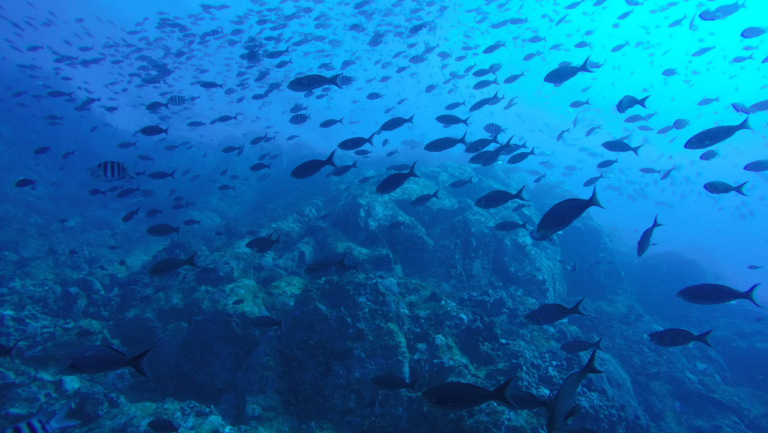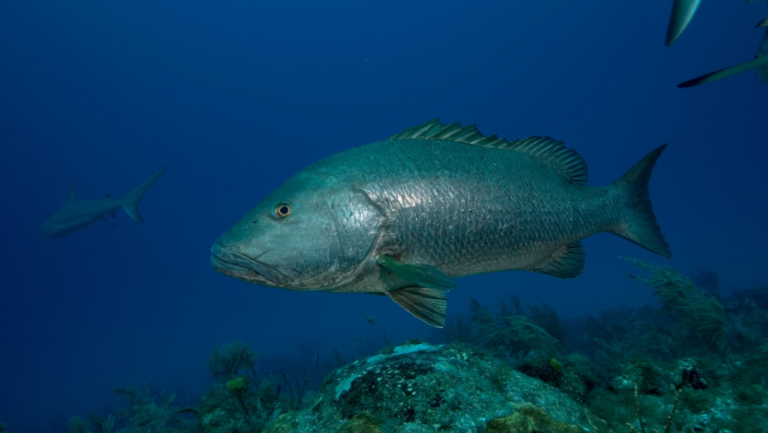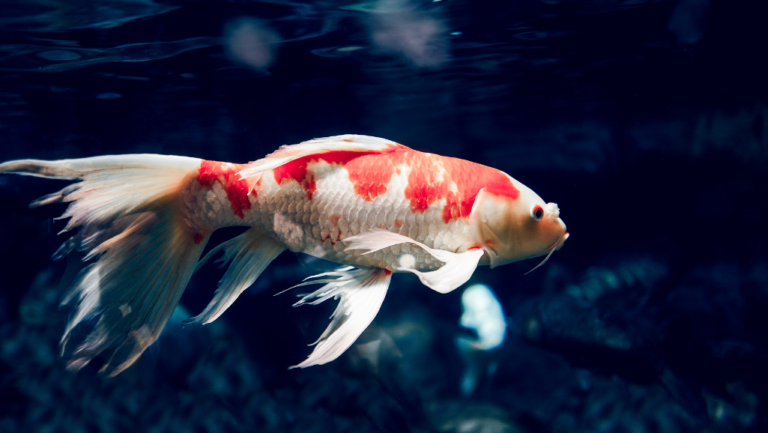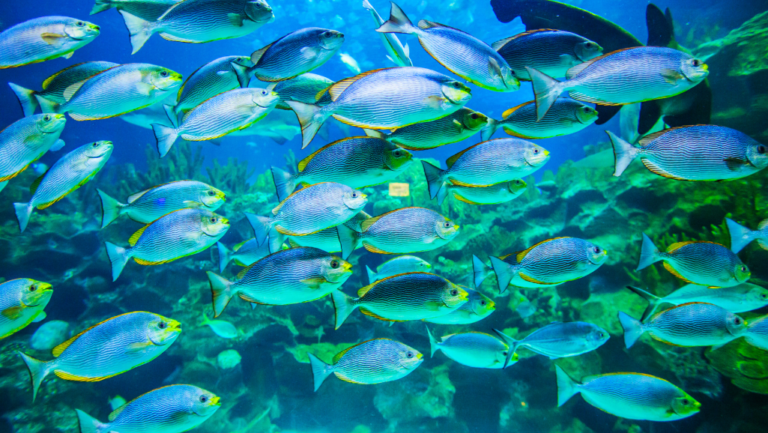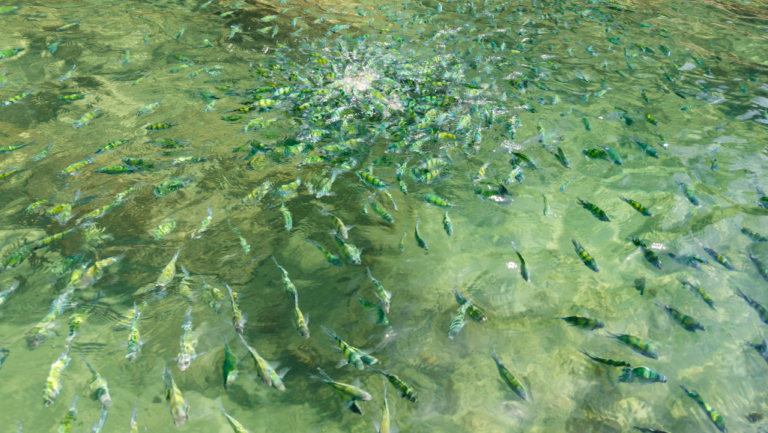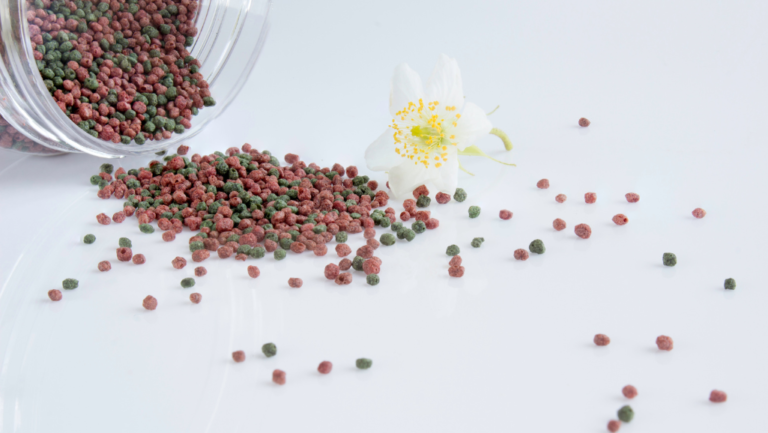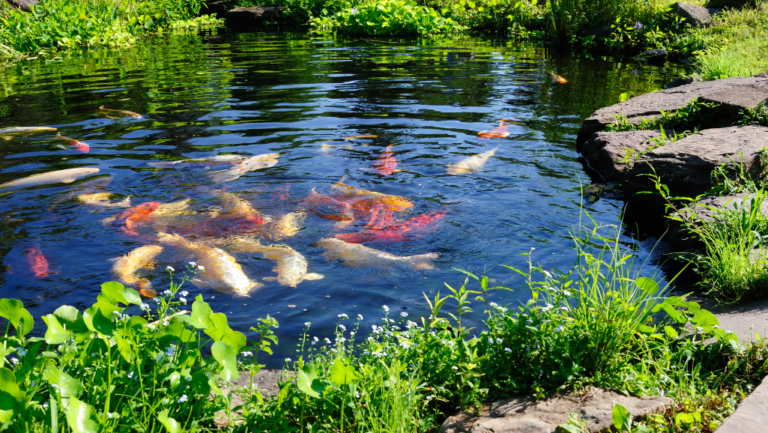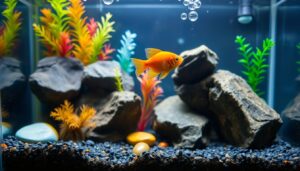Ammonia buildup in aquariums is a big threat to your fish’s health. Even a little ammonia can be very harmful. It’s important to know why ammonia builds up and how to get rid of it fast. We’ll show you how to keep your aquarium water clean and safe for your fish.
Ammonia usually comes from uneaten food, fish waste, and broken-down proteins. When ammonia levels go up, your water might get cloudy. This happens because of bacteria growth. High ammonia can also come from bad tank setup, poor filters, or not enough water flow. It’s key to fix ammonia problems quickly to keep your fish healthy.
Key Takeaways
- How to Remove Ammonia from Aquarium.
- Maintain ammonia levels as close to zero as possible to ensure fish health.
- Conduct regular water tests using an ammonia test kit, specially when setting up a new tank or adding fish.
- Perform a 10% water change with dechlorinated water on a weekly basis.
- Use products like Seachem Prime or Seachem Stability to detoxify ammonia and promote beneficial bacteria growth.
- Avoid overfeeding and limit the number of new fish added at a time to prevent ammonia spikes.
Understanding Ammonia in Aquariums
Ammonia is a natural byproduct in aquariums. It comes from fish waste, uneaten food, and decomposing organic matter. While a small amount is normal, high levels can be toxic to fish. This can lead to ammonia buildup in the aquarium. Knowing the causes and dangers of ammonia is key to a healthy aquarium.
What Causes Ammonia Buildup in Fish Tanks
Several factors can cause ammonia buildup in aquariums. These include:
- Overfeeding, which leads to excess waste production
- Overstocking the tank, resulting in higher waste levels
- Inadequate filtration or lack of beneficial bacteria
- Decomposition of dead fish or plants
- Infrequent water changes or poor tank maintenance
In new tanks, ammonia levels may spike. This is until beneficial bacteria, like nitrifying bacteria, colonize the filter. These bacteria convert ammonia to nitrite and then to nitrate, completing the nitrogen cycle. It takes about 40 days for a filter sponge to be fully colonized by these beneficial bacteria.
Dangers of High Ammonia Levels for Fish
High ammonia levels in aquariums can be extremely harmful to fish. They can cause a range of health issues and even death. Some dangers include:
- Damage to gills, making it difficult for fish to breathe
- Stress and weakened immune systems
- Irritation and inflammation of skin and fins
- Loss of appetite and lethargy
- Increased susceptibility to diseases and infections
Ammonia levels should be kept below 1 ppm to prevent harm to fish.
To protect your fish from ammonia toxicity, monitor ammonia levels regularly. Use reliable test kits and act fast if levels get too high. Water changes, better filtration, and promoting beneficial bacteria growth are important steps to manage high ammonia levels.
Testing for Ammonia in Your Aquarium
It’s important to test for ammonia in your aquarium often. Ammonia is harmful and can come from fish waste and decaying matter. High levels can hurt your fish badly, even kill them.
To keep your fish safe, test ammonia levels often. Use a good ammonia test kit for aquariums. Test daily when setting up your tank. Later, test weekly. This way, you can spot problems early and fix them.
Types of Ammonia Test Kits
There are two main types of ammonia test kits: liquid reagent kits and test strips. The API Ammonia Test Kit is popular for both freshwater and saltwater tanks.
Liquid reagent kits, like the API kit, are more accurate but take more time. Ammonia test strips are quicker but less precise.
How to Use an Ammonia Test Kit
Using an ammonia test kit is easy if you follow the instructions. Most kits need you to fill a test tube with aquarium water and add a few drops of solution.
After adding the solution, shake the tube gently and wait. The API kit takes 5 minutes, others 15-20 minutes. Then, compare the color to the chart to see the ammonia level.
Interpreting Ammonia Test Results
The goal is to keep ammonia levels at 0 ppm. If you find ammonia, act fast. A partial water change and using water conditioners like API AQUA ESSENTIAL can help.
Remember, testing often and taking action quickly is crucial. By using an ammonia test kit and acting fast, you can keep your aquarium healthy for your fish.
Performing Water Changes to Reduce Ammonia
When ammonia levels in your aquarium rise, quick action is necessary to protect your fish. One of the most effective ways to reduce ammonia is by performing water changes. Regular water changes reduce ammonia buildup, keeping your aquatic environment healthy and stable.
Importance of Regular Water Changes
Consistent water changes are crucial for maintaining optimal water quality in your fish tank. Aim to replace 10-20% of the aquarium water weekly with dechlorinated water. This helps dilute harmful substances like ammonia, nitrites, and nitrates, preventing them from reaching dangerous levels. Remember, the ideal ammonia level in a fish tank is 0 ppm.
How to Perform a Water Change Safely
To ensure a safe water change for fish, follow this simple aquarium water change procedure:
- Prepare dechlorinated water that matches the temperature of your aquarium.
- Gently remove 20-25% of the tank water using a siphon or gravel vacuum.
- Slowly add the fresh, dechlorinated water to the tank over 15-30 minutes, allowing fish to adjust gradually.
- Monitor ammonia levels closely after the water change, and repeat if necessary.
When faced with high ammonia levels, an initial 50% water change can help quickly reduce the toxicity. Follow up with daily 10-20% water changes until ammonia reaches a safe level of 0 ppm. Remember to dose your tank with Prime or Safe every 1-2 days to detoxify any remaining ammonia and nitrite.
Regular water changes are the foundation of a healthy aquarium, preventing the buildup of harmful substances like ammonia and ensuring the well-being of your fish.
Using Live Aquatic Plants to Control Ammonia
Live aquatic plants are great for any aquarium. They look good and help control ammonia naturally. Plants eat ammonia, nitrite, and nitrate, keeping the water clean and balanced.
Adding live plants to your tank helps a lot. They soak up ammonia from fish waste and uneaten food. This keeps the water safe for your fish. By controlling ammonia, plants make your fish’s home healthier, reducing stress and sickness.
Benefits of Live Plants in Aquariums
Live plants do more than just eat ammonia. They also:
- Oxygenate the water, making it better for your fish.
- Give fish places to hide and rest, making them less stressed.
- Compete with algae for food, keeping algae in check.
- Make your tank look better, making it feel more natural.
“Live aquatic plants are not only beautiful but also serve as nature’s own water purifiers, helping to maintain a healthy and thriving aquarium ecosystem.”
Best Plants for Ammonia Control
Choose fast-growing plants for best ammonia control. Some top picks are:
- Hornwort: It grows fast and absorbs nutrients well.
- Water Sprite: This plant also grows quickly and eats excess nutrients.
- Floating Plants: Duckweed and frogbit form mats that soak up nutrients and shade fish.
Aquatic plants ammonia control is a natural way to keep your tank healthy. Adding plants like these makes your tank look good and sustainable. Make sure to learn what each plant needs for it to grow well in your tank.
How to Remove Ammonia from Aquarium with Liquid Solutions
Removing ammonia from your fish tank can be quick with liquid ammonia removers for aquariums. These products bind ammonia, making it less harmful to fish. But, they don’t solve the problem of why ammonia is there in the first place.
Seachem Prime is a well-known remover that also takes care of nitrite and nitrate. API Ammo Lock is another good choice for getting rid of ammonia. These are great for emergencies or when starting a new tank.
For new tanks, using bacteria starters with removers can help start the nitrogen cycle. Seachem Stability and API Quick Start have good bacteria for breaking down ammonia and nitrite. But, building a strong bacterial colony takes a few weeks.
Neglecting water changes or having an overstocked tank can lead to high levels of ammonia, which can be detrimental to your fish’s health.
To keep your tank healthy and eliminate ammonia buildup, regular water changes are key. Doing a 50% water change weekly helps keep ammonia levels down. Also, avoid overfeeding and overstocking to prevent waste and ammonia spikes.
While liquid removers are a quick solution, they should be part of a bigger plan for aquarium care. This ensures your tank stays healthy and balanced for the long term.
Preventing Ammonia Buildup in the Future
To prevent ammonia buildup in your aquarium, it’s key to keep your tank healthy. This means using the right filter, feeding your fish right, and keeping up with tank care.
Maintaining Proper Filtration
A good filter with healthy bacteria is vital. These bacteria turn harmful ammonia into safer stuff. Make sure your filter works well and clean it with tank water, not tap water. This keeps the good bacteria safe.
Avoiding Overfeeding and Overstocking
Feeding too much can cause waste and uneaten food to rot. This leads to ammonia. Only give your fish what they eat in a few minutes. Also, don’t put too many fish in your tank. This can make waste and stress your filter.
“Excess protein in fish food can lead to higher levels of ammonia excretion.”
Regular Tank Maintenance Practices
To avoid ammonia spikes in your fish tank, stick to a cleaning schedule. Change about 30% of the water weekly. Vacuum the bottom and clean decorations as needed. This keeps your tank clean and ammonia levels low.
Always check ammonia levels with test kits. Act fast if they go up. With these steps and careful watching, your aquarium will stay healthy and free from ammonia.
Conclusion
Keeping ammonia levels in check is key for your fish’s health. Knowing what causes ammonia buildup helps you act fast. This includes avoiding overfeeding, not overcrowding, and ensuring good filtration.
Testing your water regularly with good test kits is a must. It helps spot problems early. This way, you can keep your tank’s water quality top-notch.
If ammonia levels get too high, you need to act fast. Water changes, using special solutions, and promoting beneficial bacteria can help. But, these steps only fix the symptoms, not the cause.
To keep your tank healthy long-term, prevent ammonia spikes. This means good filtration, not overfeeding, and regular tank care. A balanced ecosystem with the right fish and upkeep is crucial.
Always aim for ammonia levels below 2 mg/L-N (2 ppm-N). The goal is zero ppm. Stay alert, test often, and act quickly to keep your fish happy and healthy.
